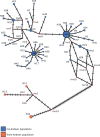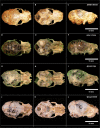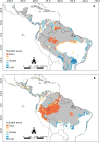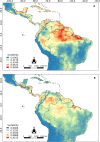Systematics and phylogeography of bats of the genus Rhynchonycteris (Chiroptera: Emballonuridae): Integrating molecular phylogenetics, ecological niche modeling and morphometric data
- PMID: 37141273
- PMCID: PMC10159116
- DOI: 10.1371/journal.pone.0285271
Systematics and phylogeography of bats of the genus Rhynchonycteris (Chiroptera: Emballonuridae): Integrating molecular phylogenetics, ecological niche modeling and morphometric data
Abstract
Rhynchonycteris is a monotypic genus of Embalonurid bats, whose geographic distribution extends from southern Mexico to tropical regions of the South American continent, including Trinidad and Tobago. Although species that have a wide geographic distribution are frequently revealed to be polytypic, to date, no study has evaluated the taxonomic status of populations of Rhynchonycteris naso. Thus, the aim of this study is to address the patterns of phylogeographic structure and taxonomic subdivision of R. naso using molecular phylogenetics, morphometric data and ecological niche modeling. Phylogenetic results recovered using the genes COI, Cytb, Chd1, Dby, and Usp9x, supported the monophyly of the genus Rhynchonycteris, in addition, a deep phylogeographic structure was revealed by the mitochondrial gene COI for the populations of Belize and Panama in comparison to those of South America. The PCA, and the linear morphometry indicated an apparent differentiation between the cis-Andean and trans-Andean populations. Furthermore, according to the skull morphology, at least two morphotypes were identified. Ecological niche modeling projections in the present have shown that the Andean cordillera acts as a climatic barrier between these two populations, with the depression of Yaracuy (Northwest Venezuela) being the only putative climatically suitable path that could communicate these two populations. On the other hand, projections for the last glacial maximum showed a drastic decrease in climatically suitable areas for the species, suggesting that cycles of lower temperatures played an important role in the separation of these populations.
Copyright: © 2023 Biganzoli-Rangel et al. This is an open access article distributed under the terms of the Creative Commons Attribution License, which permits unrestricted use, distribution, and reproduction in any medium, provided the original author and source are credited.
Conflict of interest statement
The authors have declared that no competing interests exist.
Figures











References
-
- Simmons NB. Mammal species of the world: a taxonomic and geographic reference. Order Chiroptera. 3rd edition. Baltimore: Johns Hopkins University Press; 2005.
-
- Lim BK, Engstrom MD, Reid FA, Simmons NB, Voss RS, Fleck DW. A new species of Peropteryx (Chiroptera: Emballonuridae) from western Amazonia with comments on phylogenetic relationships within the genus. American Museum Novitates. 2010; 3686: 1–20.
-
- Vaughan TA, Ryan JM, Czaplewski NJ. Mammalogy. 6th edition. Massachusetts: Jones & Bartlett Publishers; 2013.
-
- Ghanem SJ, Voigt CC. Increasing awareness of ecosystem services provided by bats. In: Brockmann HJ, Roper TJ, Naguib M, Mitani JC, editors. Advances in the Study of Behavior Amsterdam: Academic Press; 2013. pp. 279–302.
-
- Russo D, Bosso L, Ancillotto L. Novel perspectives on bat insectivory highlight the value of this ecosystem service in farmland: Research frontiers and management implications. Agriculture, Ecosystems & Environment. 2018; 266: 31–38.
Publication types
MeSH terms
Substances
LinkOut - more resources
Full Text Sources

